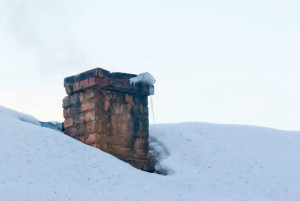Fall and winter is the heaviest use season for most fireplaces and other heating appliances. Not only do they help keep your home warm, but they also create a cozy and welcoming atmosphere that invites friends and family to sit back, relax, and stay a while.
Because fireplace systems are used most often during the winter, it is important to make sure they are prepped and ready to go for when cold weather arrives. The following are five ways that you can help prepare your fireplace for winter.
1. Warm up the flue
If the outside air temperature is significantly colder than the temperature inside your home, you may have trouble starting a fire. If your home has a strong smoky smell or smoke blows back into the room for the first few minutes after you light a fire, you may want to try warming the flue.
Warming up the flue is simple, easy to do, and should be done before every fire if you have problems with drafting. To warm the flue, first open the damper completely. Light a small bunch of kindling or newspaper and hold it directly below the opening of the flue for several minutes before lighting the main fire. As the warm air from the small fire rises, it will push out the cold air in the chimney – without pushing smoke back into your home.
2. Burn the right firewood
Buying and burning the right firewood can have a big impact on your fireplace system. Homeowners should try to only burn seasoned hardwoods like ash, elm, and oak in their fireplaces. Hardwood produce less smoke and burn longer than soft woods; likewise, seasoned firewood creates significantly less creosote when burned than freshly cut wood.
3. Avoid overloading the fireplace
How you stack your firewood can have a big impact on fireplace performance. Instead of nearly filling the fireplace with wood to create a big fire, opt instead for a smaller stack; small fires can burn hotter and more completely than a larger, smoldering fire; in addition to producing more heat, this can also minimize creosote production. For added effect, try experiment with different fireplace stacking techniques.
4. Use safety equipment
If you have small children or pets in the house, make sure you’re using safety equipment to protect them when the fireplace is in use. Glass doors, spark guards, and metal screens are all ways to keep coals and embers from popping out and into your home – as well as prevent little fingers from reaching in.
5. Call a chimney sweep
If you’re concerned at all about your fireplaces safety and efficiency, it may be time to call a chimney sweep. The National Fire Protection Association recommends that chimneys be swept at least once per year – or more, depending on how often your fireplace or heating appliance is used. Having your chimney swept each year removes ash, soot, and highly flammable creosote as well as gives a certified professional the opportunity to inspect your fireplace and chimney for any signs of damage or deterioration.
Taking these few simple steps can help you make sure your fireplace is ready for winter. If you are in South New Jersey and need high quality chimney care for your fireplace, contact Mason’s Chimney Service today.

